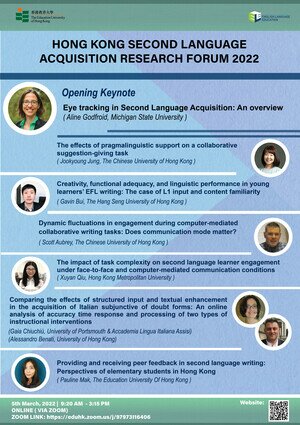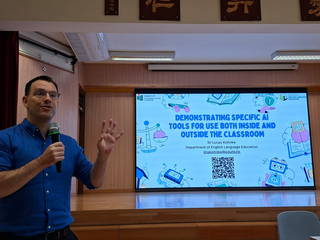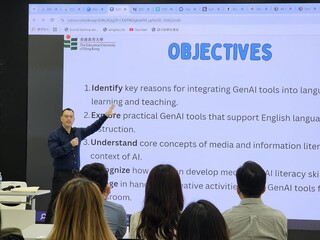Hong Kong Second Language Acquisition Research Forum 2022
- 05 Mar, 2022 | 9:20am - 3:00 pm
- Online via ZOOM
- Forum
- English
- Department of English Language Education
IMPORTANT ANNOUNCEMENT:
The session titled "Dynamic fluctuations in engagement during computer-mediated collaborative writing tasks. Does communication mode matter?" by Scott Aubrey (The Chinese University of Hong Kong) is cancelled.
Hong Kong Second Language Acquisition Research Forum (HK-SLARF) represents a group of academics working in Hong Kong who share an interest in second language acquisition (SLA). This colloquium is a forum in which we present papers on our latest research and discuss developments in the field of SLA.
Hong Kong Second Language Acquisition Research Forum 2022
The recording of eye movements, or eye tracking, has become an important tool for language researchers to probe real-time cognitive processes in first and second language speakers. Researchers turn to eye tracking for its millisecond precise temporal information and its high spatial resolution. As an exquisitely versatile tool, eye tracking has many applications across SLA disciplines and inspires new work, as well as new takes on old questions each year (see Godfroid, 2019, 2020; Godfroid & Hui, 2020; Godfroid, Winke, & Conklin, 2020, for reviews).
When participants engage in a language task, their eye gaze may provide a measure of their attentional allocation and linguistic processing (Godfroid, Boers & Housen, 2013; Just & Carpenter, 1980; Reichle, Pollatsek, & Rayner, 2006; Smith, 2012). This technology can be used to capture both conscious and unconscious processing in language learning and processing, which opens up new avenues for research in linguistics, psycholinguistics, instructed second language acquisition, and discourse studies, among many others.
In this keynote address, I will render the depth and breadth of eye-tracking research in second-language research, sampling influential studies across different SLA disciplines and highlighting how each study benefited in unique ways from the use of eye-movement registration. The talk will conclude with a discussion of methodological aspects to consider with a view to promoting sound and reproducible eye-tracking research in the scientific study of language.
The present study attempted to examine if pragmalinguistic support would affect EFL learners' performance in a collaborative suggetion-giving task. The participants for this study were twelve pairs of EFL learners in a Zoom-mediated university course. They were asked to provide suggestions for improvement in their peers' presentations using Office 365. Six pairs received pragmalinguistic support, while the other pairs had to write suggestions on their own. Data came from audio-recordings of their pair discussions and their written suggestions. The results indicated that pragmalinguistic support led the participants to attend better to language-related and task-related aspects in their collaborative suggestion writing. Also, their suggestions demonstrated more various downgraders that were to mitigate the negative tone. By contrast, the other six pairs produced more pragmatic-related discussions, showing heavier reliance on epistemic modal verbs (e.g., would). The findings of this study suggest that pragmalinguistic support may encourage EFL learners to acquire and practice new L2 pragmatic aspects when performing collaborative tasks, and thereby produce linguistically and pragmatically richer output.
Much has been researched in second language (L2) writing performance, such as corrective feedback (e.g., Lee, 2017 and elsewhere), general writing quality (e.g., Casal & Lee, 2019), and textual emotionality (e.g., Tabari, Bui, & Wang, 2021). However, creativity and functional adequacy as two crucial components of writing quality, especially in creative L2 writing tasks by young learners, have not received much attention in prior literature. This research explored the effects of L1 reading input and young learners’ familiarity with the writing topics on their creativity, functional adequacy and general language features through an experimental design. The results showed that L1 reading input was debilitative to creativity regardless of content familiarity. In general, learners’ content familiarity with the writing topics gave rise to better writing fluency and linguistic accuracy while L1 reading input encouraged greater linguistic complexity. In addition, creativity was positively correlated with idea units, linguistic accuracy, and lexical diversity. However, it was negatively associated with syntactic complexity and lexical sophistication. Functional adequacy rating was found to be difficult with these creative writing tasks by young learners and we will discuss how functional adequacy and creativity measures could be improved from a methodological perspective.
Acknowledgement:
This research was supported by Research Grants Council, University Grants Committee, Hong Kong. Ref. No. UGC/FDS14/H13/20.
In computer-mediated collaborative writing research, there is a need to more fully understanding how online tools can promote optimal levels of collaboration, learner engagement and task performance. This presentation reports on a study that takes a dynamic approach to investigating engagement during online collaborative L2 writing tasks. Using online conference software and online editing software, 16 Hong Kong university students (L1: Cantonese) completed two timed collaborative writing tasks in English in different communication modes: video chat and text chat. After each task, learners viewed videos of their performances in 12 three-minute segments and were asked to rate their engagement on two scales (interest, focus) for each segment. They were then interviewed about their attributions for fluctuations in their ratings. A group-level analysis revealed that learners experienced significantly higher focus and interest during tasks performed in video chat mode than text chat mode. This was contrasted with an analysis from a dynamic perspective, which produced a more nuanced picture of individual engagement trajectories during the tasks. Patterns of engagement fell into either moderately steady, increasing, decreasing, or unstable pattern categories. While the text chat condition generated more increasing patterns, patterns of engagement during video chat performances tended to be more stable. A content analysis of 32 interviews revealed four factors that accounted for changes in engagement during tasks: task design (e.g., task familiarity), task process (e.g., instances of collaboration), task condition (e.g., communication mode), and learner factors (e.g., perceptions of proficiency). The presentation will conclude with a discussion of how different computer-mediated communication modes can be combined to meet the engagement needs of learners during writing.
This study investigates the effects of task complexity on thirty-six English as a second language (ESL) learners’ engagement in task performance under the face-to-face real-time communication (F2F) and the synchronous video-based computer-mediated communication (SvCMC) conditions. The participants, who were randomly divided into the F2F group and the SvCMC group, formed their self-initiated pairs and performed three oral tasks (simple, +complex, and ++complex conditions) in the counterbalanced order. After their task performance, the learners were interviewed about their emotional feelings when performing the tasks. The analysis of the spoken discourse revealed that the F2F learners spent a longer time and uttered more words in the +complex task than in the other two tasks. Both groups of learners produced more elaborative clauses as the task complexity increased. The SvCMC group held more negotiations on clarifying content in the simple and ++complex tasks than their F2F peers did. The mixed emotions reported by the participants imply the potential role of individual differences in learner engagement. Pedagogical implications of the findings will be discussed in the presentation.
The present study is an investigation into relative effects of structured input (the core component of processing instruction) and textual enhancement on the acquisition of Italian subjunctive of doubt forms. A pre/post-test procedure was adopted in this study using self-paced reading to measure changes in processing behaviors. Participants were Chinese L1 enrolled in an Italian language training program in Italy. Self-paced reading tests consisted of forty sentences and thirty comprehension questions. Instruction took place across two consecutive days. During the treatment period participants didn’t receive any feedback on their performance and the target feature. No explicit information about the target feature was provided. The on-line measurements analysis provide important insights on the individual and instructional groups processing behaviors.
Peer feedback has a pivotal role to play in enhancing student agency in the assessment process, as well as contributing to increased student confidence, the growth of metacognitive skills, and development of writing skills. Despite the accolades found in research on peer feedback, the utilization of such a feedback approach has not been widely practised in some L2 writing contexts. While previous research has focused on the benefits of peer feedback for either the reviewer or the receiver, there exists a paucity of studies that explore its effectiveness to students who assume the dual role in the peer feedback process. Among the studies on peer feedback in L2 writing, the focus has been placed on secondary and tertiary settings, with fewer studies conducted in elementary schools. To address this gap, the current study reports on a multiple case study conducted against this backdrop to investigate how and to what extent elementary students of different proficiency levels of two primary schools in Hong Kong benefit from giving and receiving feedback from their peers on their writing. Multiple sources of data were gathered for one academic year including group interviews and simulated recall with students, students’ written drafts with peers’ feedback and classroom observation of peer feedback sessions. The findings revealed that the students’ perceived benefits derived from peer feedback are mediated by multiple influences such as students’ individual differences, levels of peer training, clarification of genre-specific assessment criteria and within-class grouping. The presentation concludes with implications for the pedagogy of peer feedback in analogous educational contexts.







